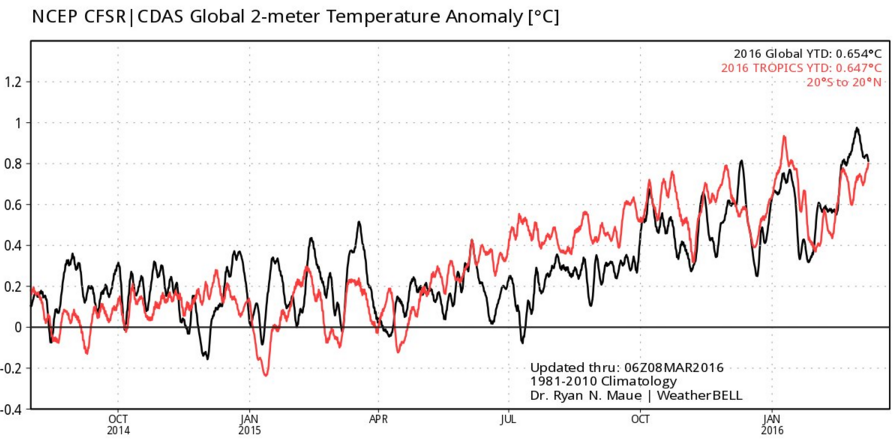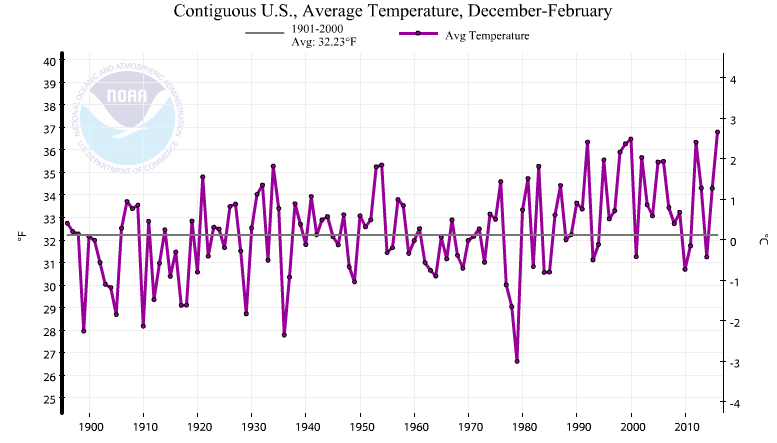Thanks to a convergence of sizzling hot weather and climate phenomena, this winter incinerated temperature records across the U.S.
In the lower 48 states, the average temperature between December and February was 4.6 degrees Fahrenheit above the 20th century average, according to the National Oceanic and Atmospheric Administration. As a result, this winter broke the previous record set in 1999 and 2000.
February was particularly hot, with average temperatures soaring to 5.7 degrees above the 20th century average.

Temperatures were high across the globe as well.
John Fasullo, a project scientist at the National Center for Atmospheric Research, told BuzzFeed News the first month of 2016 was the warmest January on record, with temperatures up nearly 2 degrees over the 20th century average.
"So far we're looking at an exceptionally warm year," he added.
According to NOAA, January 2016 broke the previous record for the month that was set in 2007.
El Niño was partially responsible for the extreme heat.
Ryan Maue, a meteorologist at WeatherBell Analytics, said high temperatures typically follow an El Niño. The data bears that out, with global temperatures — represented below with the black line — rising for several months after temperatures in the tropics, the red line, also rose. The tropics includes the region where a strong El Niño formed last year, and has since begun to weaken.

For Fasullo, the high temperatures were not in themselves especially surprising, though he said what is impressive was how "separate pieces of a puzzle" came together to produce higher temperatures in different regions, especially in the U.S. In addition to El Niño, he pointed to the North Atlantic Oscillation, which drove temperatures higher in the Northeast, as well as a high pressure system that blocked cooling rain and clouds in the Southwest.
And warmer temperatures could continue into 2016.
"January is the warmest on record and El Niño increases the odds of continuing very warm temperatures," Fasullo said.

Climate change also played a factor — though claims that the world hit an apocalyptic climate milestone are overblown.
Both Maue and Fasullo noted that the warmer weather this winter happened against the backdrop of climate change, which is driving temperatures up gradually over time.
In other words, both shorter-term weather and longer term trends are responsible for the heat.
But the apocalypse is not nigh.
Climate scientists use Celsius to measure temperature and many believe a global rise of 2 degrees above levels prior to the industrial revolution would be disastrous. In fact, the primary overarching objective of the Paris climate talks in December was to prevent global temperatures from rising an average of 2 degrees.
Data shows average temperatures in the Northern Hemisphere did actually rise, briefly, to around 2 degrees C above average in February.
But Maue said the average temperature rise discussed by climate scientists is a yearly average, while the spike in February was just that — a temporary spike.
"That's weather, that's not climate," he said, adding "we're not expected to hit 2 degrees C until the end of the century."
Fasullo said average yearly global temperatures have risen by slightly more than 1 degree C over pre-industrial levels.
But while the world didn't hit the 2 degree C average milestone that scientists and leaders have vowed to prevent, in Paris and elsewhere, rising temperatures do foreshadow a hotter future.
"Before the global average hits 2 degrees C," Maue said, "there are going to be days that hit that temperature."

